|
|
 |
| ............................................................. |
|
|
| ........................................................ |
| From
the Editor |

|
Editorial
A. Abyad (Chief Editor) |
|
|
|
|
........................................................ |
Special
Education feature - Part 2
........................................................
Research
........................................................
Case Report
........................................................
Education Review
|
Middle
East Quality Improvement Program
(MEQUIP QI&CPD)
|
|
Chief
Editor -
Abdulrazak
Abyad
MD, MPH, MBA, AGSF, AFCHSE
.........................................................
Editorial
Office -
Abyad Medical Center & Middle East Longevity
Institute
Azmi Street, Abdo Center,
PO BOX 618
Tripoli, Lebanon
Phone: (961) 6-443684
Fax: (961) 6-443685
Email:
aabyad@cyberia.net.lb
.........................................................
Publisher
-
Lesley
Pocock
medi+WORLD International
11 Colston Avenue,
Sherbrooke 3789
AUSTRALIA
Phone: +61 (3) 9005 9847
Fax: +61 (3) 9012 5857
Email:
lesleypocock@mediworld.com.au
.........................................................
Editorial
Enquiries -
abyad@cyberia.net.lb
.........................................................
Advertising
Enquiries -
lesleypocock@mediworld.com.au
.........................................................
While all
efforts have been made to ensure the accuracy
of the information in this journal, opinions
expressed are those of the authors and do not
necessarily reflect the views of The Publishers,
Editor or the Editorial Board. The publishers,
Editor and Editorial Board cannot be held responsible
for errors or any consequences arising from
the use of information contained in this journal;
or the views and opinions expressed. Publication
of any advertisements does not constitute any
endorsement by the Publishers and Editors of
the product advertised.
The contents
of this journal are copyright. Apart from any
fair dealing for purposes of private study,
research, criticism or review, as permitted
under the Australian Copyright Act, no part
of this program may be reproduced without the
permission of the publisher.
|
|
|
| November 2016
- Volume 14, Issue 9 |
|
|
CME Needs Assessment:
National Model - Dental CME
Abdulrazak
Abyad (1)
Ninette Bandy (2)
(1) Abdulrazak Abyad, MD, MPH, MBA, AGSF
(2) Ninette Banday, BDS, MPH, DMSc, FICOI,FICD
Correspondence:
Dr Abdulrazak Abyad
Email: aabyad@cyberia.net.lb
This
CME Needs Assessment paper was written to provide
analysis on a particular regional country’s
<<the country>> proposed CME in
Primary Care program. It has been provided as
a National Model that other countries may wish
to replicate.
In
this new millennium most nations, both developed
and developing are actively reviewing national
health policies and strategies as well as health
delivery systems. The over-riding imperative
in all cases is to deliver quality health care
in a cost efficient manner while addressing
issues of access and equity.
The provision of
health services in <<the country>>
is divided into federal, local and private sectors.
The Health Authority, and the local government
agency is responsible for the provision of integrated,
comprehensive, and quality of health services
for its population.
As
in
most
areas
of
education,
for
many
years
there
has
been
intense
debate
about
the
definition,
purpose,
validity,
and
methods
of
learning
needs
assessment.
It
might
be
to
help
curriculum
planning,
diagnose
individual
problems,
assess
student
learning,
demonstrate
accountability,
improve
practice
and
safety,
or
offer
individual
feedback
and
educational
intervention.
Published
classifications
include
felt
needs
(what
people
say
they
need),
expressed
needs
(expressed
in
action)
normative
needs
(defined
by
experts),
and
comparative
needs
(group
comparison).
Other
distinctions
include
individual
versus
organizational
or
group
needs,
clinical
versus
administrative
needs,
and
subjective
versus
objectively
measured
needs.
The
defined
purpose
of
the
needs
assessment
should
determine
the
methods
used
and
the
use
made
of
the
findings.
Exclusive
reliance
on
formal
needs
assessment
in
educational
planning
could
render
education
an
instrumental
and
narrow
process
rather
than
a
creative,
professional
one.
| METHODS
OF
NEEDS
ASSESSMENT |
Although
the
literature
generally
reports
only
on
the
more
formal
methods
of
needs
assessment,
doctors
and
dentists
use
a
wide
range
of
informal
ways
of
identifying
learning
needs
as
part
of
their
ordinary
practice.
These
should
not
be
undervalued
simply
because
they
do
not
resemble
research.
Questionnaires
and
structured
interviews
seem
to
be
the
most
commonly
reported
methods
of
needs
assessment,
but
such
methods
are
also
used
for
evaluation,
assessment,
management,
education,
and
now
appraisal
and
revalidation.
The
main
purpose
of
needs
assessment
must
be
to
help
educational
planning,
but
this
must
not
lead
to
too
narrow
a
vision
of
learning.
Learning
in
a
profession
is
unlike
any
other
kind
of
learning.
Doctors
and
dentists
live
in
a
rich
learning
environment,
constantly
involved
in
and
surrounded
by
professional
interaction
and
conversation,
educational
events,
information,
and
feedback.
The
search
for
the
one
best
or
"right"
way
of
learning
is
a
hopeless
task,
especially
if
this
is
combined
with
attempting
to
"measure"
observable
learning.
Research
papers
show,
at
best,
the
complexity
of
the
process.
Multiple
interventions
targeted
at
specific
behavior
result
in
positive
change
in
that
behavior.
Exactly
what
those
interventions
are
is
less
important
than
their
multiplicity
and
targeted
nature.
On
the
other
hand,
different
doctors
and
dentists
use
different
learning
methods
to
meet
their
individual
needs.
For
example,
in
a
study
of
366
primary
care
doctors
who
identified
recent
clinical
problems
for
which
they
needed
more
knowledge
or
skill
to
solve,
55
different
learning
methods
were
selected.
The
type
of
problem
turned
out
to
be
the
major
determinant
of
the
learning
method
chosen,
so
there
may
not
be
one
educational
solution
to
the
identified
needs.
Much
of
a
doctors'
and
a
dentists'
learning
is
integrated
with
their
practice
and
arises
from
it.
The
style
of
integrated
practice
and
learning
("situated
learning")
develops
during
the
successive
stages
of
medical
education.
The
components
of
apprenticeship
learning
in
postgraduate
training
are
made
up
of
many
activities
that
may
be
regarded
as
part
of
practice
(13).
Senior
health
professionals
might
also
recognize
much
of
their
learning
in
some
of
these
elements
and
could
certainly
add
more-such
as
conversations
with
colleagues.
Thus,
educational
planning
on
the
basis
of
identified
needs
faces
real
challenges
in
making
learning
appropriate
to
and
integrated
with
professional
style
and
practice.
The
first
step
is
to
recognize
the
need
of
learning
that
are
a
part
of
daily
professional
life
in
medicine
and
to
formalize,
highlight,
and
use
these
as
the
basis
of
future
recorded
needs
assessment
and
subsequent
planning
and
action,
as
well
as
integrating
them
with
more
formal
methods
of
needs
assessment
to
form
a
routine
part
of
training,
learning,
and
improving
practice.
Quality
health
care
for
patients
is
supported
by
maintenance
and
enhancement
of
clinical,
management
and
personal
skills.
The
knowledge
and
skills
of
practitioners
require
refreshment,
and
good
professional
attitudes
need
to
be
fostered
through
the
process
of
continuing
professional
development.
In
an
attempt
to
assess
the
needs
for
professional
development
of
the
medical,
dental
practitioners
and
nursing
staff
a
survey
was
conducted
by
means
of
a
Questionnaire
(APPENDIX
).
This
report
takes
into
account
a
wide
section
of
the
various
medical,
dental
and
nursing
staff.
The
purposes
of
the
review,
therefore
were
to:
•
Determine
the
area
of
professional
development
•
Help
thehealth
professional
,
meet
the
challenge
of
changes
in
the
structure
and
delivery
of
patient
care.
•
Encourage
more
reflection
on
practice
&
learning
needs,
including
more
forward
planning;
and
•
Make
the
educational
methods
used
in
practice
more
effective
| PART
I-
DEMOGRAPHIC
DATA
(SEE
APPENDIX) |
465
questionnaires
were
included
in
the
study
out
of
600
hundreds
distributed.
The
exclusion
criteria
were
that
either
the
questionnaire
was
not
returned
or
was
incomplete.
The
response
rate
was
77
percent.
The
mean
age
of
the
study
population
was
42years
(SD
9.70)
with
the
minimum
age
being
23
years
and
maximum
being
74years.
72%
of
the
study
populations
were
below
50
years.
The
mean
of
the
number
of
years
since
graduation
was
18
years
(mean
=8.46,
SD=9.16).
Whereas
the
mean
of
the
number
of
years
in
practice
was
17
years
(Mean=17.18,
SD=9.16).
As
for
gender
distribution
35%
of
the
samples
were
males
vs
65%
who
were
females.
| TOPICS
FOR
THE
CME
FOR
DENTISTS
AND
DENTAL
ASSISTANTS
|
The
report
includes
the
details
of
the
ratings
on
various
topics,
however
the
topics
that
received
the
highest
ratings
were:
Infection
control,
management
of
the
medically
compromised
patients,
Diagnosis
&
Treatment
planning,
Dental
radiology
&
its
interpretation,
preventive
dentistry,
dental
composites
and
endodontics.
The
response
rate
for
the
monthly
activity
was
the
highest
with
Hands
-
workshops.
Assessment
Strategies
In
the
implementation
of
any
CME
activities
assessment
strategies
is
critical
to
judge
the
success
of
such
a
program.
For
example
communication
skills
learning
must
be
both
formative
and
summative.
The
knowledge,
skills,
and
attitudes
to
be
assessed
must
be
made
explicit
to
both
learners
and
teachers
alike.
Potential
evaluators
include
local
experts,
course
faculty,
simulated
and
real
patients,
peers,
and
the
learners
themselves.
Formative
assessment
should
occur
throughout
the
communication
skills
curriculum
and
is
intended
to
shape
and
improve
future
behaviors.
Assessment
of
communication
skills
must
include
direct
observation
of
performance.
Evaluation
of
setting
a
therapeutic
environment,
gathering
data
and
providing
information
and
closure
must
be
included.
Evaluation
of
advanced
skills,
including
use
of
interpreters,
providing
bad
news
and
promoting
behavior
change
should
be
done
as
well.
Criteria
should
match
the
novice
level
of
the
end
of
second
year
student,
who
should
be
able
to
identify
the
critical
issues
for
effective
communication
and
perform
the
skills
under
straightforward
circumstances.
Quality
CME
can
enhance
the
knowledge
base
and
practice
skills
of
the
participating
health
care
provider
and
is
increasingly
used
as
part
of
the
credentialing
and
reappointment
process.
Continuing
Medical
Education
is
important
not
only
as
a
requirement
for
practice,
but
as
means
for
the
profession
to
achieve
one
of
its
primary
goals:
QUALITY
PATIENT
CARE.
To
our
patients
CME
requirements
are
a
commitment
made
by
the
medical
and
dental
practitioner
to
keep
our
knowledge
and
skills
current.
CME
really
is
about
changing
behavior
through
education-about
doing
something
different,
doing
it
better."
It
is
critical
to
look
at
CME
and
CPD
in
the
mentality
of
21st
century.
We
attempted
to
clearly
present:
that
the
patient's
concerns,
values
and
outcomes
must
be
the
center
of
care;
that
partnering
with
an
activated
patient
is
essential;
that
self-awareness
is
essential
in
being
an
effective
physician;
that
improving
the
process
of
care
and
health
outcomes
is
the
physician's
responsibility
and
requires
a
systems
approach.
Quality
CME
can
enhance
the
knowledge
base
and
practice
skills
of
the
participating
health
care
provider
and
is
increasingly
used
as
part
of
the
credentialing
and
reappointment
process.
Continuing
Education
is
important
not
only
as
a
requirement
for
practice,
but
as
means
for
the
profession
to
achieve
one
of
its
primary
goals:
QUALITY
PATIENT
CARE.
To
our
patients
CME
requirements
are
a
commitment
made
by
the
medical
and
dental
practitioner
to
keep
our
knowledge
and
skills
current.
|
DENTAL
CARE
EDUCATION
INITIATIVE
|
The
topics
that
were
covered
in
the
survey
included
the
following
CME
FOR
DENTISTS
AND
DENTAL
ASSISTANT
Infection
Control
The
Patient
Management
Skills
Preventive
Dentistry
Restorative
&
Esthetic
Dentistry
Endodontics
Pedodontics.
Periodontics.
Prosthodontics
Oral
Surgery
Implantology
Health
Promotional
Activities
&
Oral
Health
Education
Format
of
CME
Timing
of
the
CME
Type
of
Activities
Self
Study
Results
of
Survey
The
response
to
the
various
topics
in
dentistry
is
presented
in
Tables
1-3
.
These
topics
were
rated
similarly
as
the
topics
in
medicine
with:
a)
Order
of
importance
of
the
topic.
(1
=
least
important
to
5
=
most
important)
b)
Rating
your
own
current
level
of
Knowledge/performance.
(1
=
basic
to
5
=
highly
skilled)
c)
Recommend
CME
activity
on
level
of
priority
(1
=
least
to
5
=
highest
priority)
Table
1
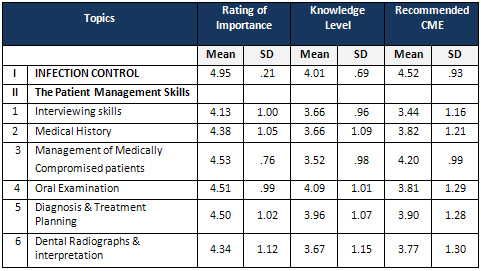
Table
2
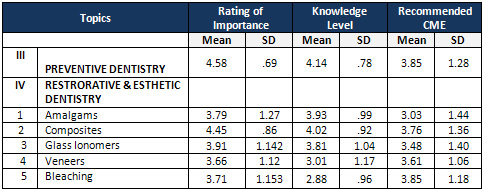
Table
3
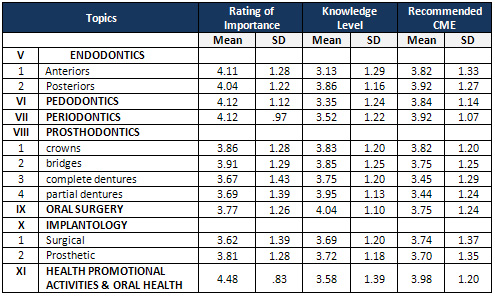
Attempt
was
made
to
establish
the
most
suitable
timings
and
frequency
of
the
CME
activities.
The
ratings
adopted
were
:
1
being
least
appropriate,
5
most
appropriate.
The
results
are
presented
in
Table
4
and
the
need
for
a
monthly
activity
was
rated
highest
3.95
with
Hands-
on
Training
Table
5
Table
4:
Timing
of
CME
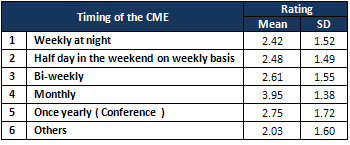
Table
5:
Type
of
Activities
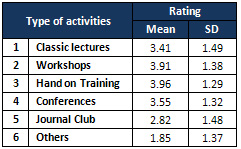
Table
6:
Self
Study
Methods
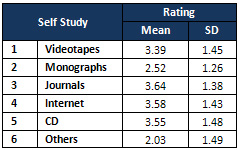
| OVERALL
EVALUATION
AND
NEED
FOR
IMPROVEMENT
|
As
curricula
and
methodologies
for
the
training
of
physicians
approach
the
100-year
anniversary
of
the
Flexner
report
(2010),
it
is
important
to
recognize
that
medical
education
has
been
a
constantly
evolving
process
to
address
the
training
needs
of
physicians
to
serve
society
and
its
people.
Understanding
curricular
reform
is
one
of
understanding
its
history.
Many
reports
prior
to
1990
(e.g.
Rappleye,
GPEP,
Macy
Foundation)
comment
on
the
process,
as
well
as
the
content
and
structure
of
medical
education.
Several
have
noted
the
glacial
progress
of
reform
and
the
reasons
behind
this
pace.
More
recently
in
the
1990s
and
the
new
century,
the
breadth
of
involved
stakeholders
in
this
process
has
widened,
as
many
entities
within
and
beyond
medical
schools
have
identified
significant
needs
in
the
process
of
education
of
physicians
for
the
21st
century.
These
defined
challenges
reflect
not
only
the
explosion
of
medical
knowledge
and
technology
and
the
changing
demographics
of
the
population,
but
also
the
broader
societal
and
health
care
system
changes
that
are
significantly
affecting
the
contextual
environment
in
which
medicine
is
practiced.
There
is
a
need
to
improve
and
train
people
responsible
for
CME
and
CPD
activities.
Traditional
educational
practice
in
medical
schools
emphasize
the
organ
systems
and
discipline-based
approaches,
but
in
Primary
Health
Care
,
faculty
development
is
necessary
to
ensure
effective
team
teaching
approaches,
interdisciplinary
collaboration,
integration
of
material
across
disciplines
and
courses,
and
focus
on
patient
health
outcomes.
The
integration
of
these
concepts
needs
to
be
across
the
curriculum
and
in
every
course
rather
than
adding
additional
curricular
time.
Faculty
development
in
adult
education
techniques
may
be
necessary.
Faculty
development
for
role
modeling
and
mentoring
techniques
should
be
considered.
The
response
rate
from
the
survey
was
relatively
high,
reflecting
the
interest
of
the
primary
health
care
team
in
CME
and
CPD.
There
are
a
number
of
Barriers
to
obtaining
optimal
CME
including
lack
of
time
and
type
of
activities.
Lack
of
time
Lack
of
time
was
seen
as
the
biggest
barrier
to
obtaining
optimal
CME.
All
CME
was
carried
out
in
personal
time.
'It
means
night-time
or
weekends.
CME
activity
has
to
fit
in
with
on
call
and
family.
'I
am
a
working
mother,
time
is
the
essence.'
In
our
survey
(table
6)
most
health
care
members
preferred
CME
activity
on
a
monthly
basis
which
reflects
that
time
is
precious
for
the
busy
health
professionals.
Motivation
and
fatigue
were
other
barriers
to
CME.
Distance,
availability
and
cost
were
seldom
raised
as
issues
for
urban
GPs.
However,
distance
precluded
attendance
for
many
rural
practitioners,
as
did
difficulty
obtaining
locums,
cover
for
single
days,
availability
of
CME
and
financial
considerations.
The
perceived
challenge
was
to
increase
the
accessibility
of
personally-interactive
CME.
A
number
of
studies
have
shown
preference
of
GPs
for
personal
interaction.
Some
studies
have
shown
a
preference
amongst
physicians
for
lectures
but
this
may
include
interaction.
Others
have
found
journals
the
most
popular
source
of
information
but
interactive
formats
were
still
highly
rated.
Preference
depends
on
the
type
and
quality
of
personal
experience
of
this
type
of
format.
Pendleton
differentiated
the
academic
and
professional
approach
to
CME.
He
postulated
that
the
academic
prefers
the
written
medium
and
the
clinician
prefers
face-to-face.
In
our
survey
the
respondents
preferred
the
most
hand
on
training,
workshop,
and
conferences.
Review
of
randomized
controlled
trials
on
CME
interventions
revealed
that
personal
interaction
to
be
central
to
effectiveness
in
change
in
practice.
Several
studies
have
reported
that
physicians
seek
confirmation
and
validation
of
current
and
new
medical
practices
through
their
peers.
Other
studies
have
confirmed
the
importance
of
interaction
in
changing
professional
behavior.
However,
it
has
not
been
established
which
elements
of
the
interactive
process
enable
learning.
Interaction
allows
for
clarification,
personalisation
of
information,
exploration,
feedback,
and
reflection.
It
can
also
address
other
needs
of
doctors
that
may
not
be
recognized
or
quantified
-
the
need
for
support,
recognition,
motivation
and
fulfillment,
and
the
'need'
to
belong
to
a
professional
community.
As
for
self
study
methods
the
respondent
preferred
mostly
journals
followed
by
the
internet
followed
by
CD
as
shown
in
Table
6.
Interactive
formats
are
not
inherently
beneficial
nor
always
produce
change.
Some
formats
may
be
more
conducive
to
specific
changes
in
behavior
and
some
to
support.
Group
dynamics,
facilitation,
personal
agendas,
and
internal
and
external
influences
contribute
to
the
complexity
of
the
format.
In
general,
the
focus
was
on
choice
of
CME
as
opposed
to
other
elements
of
the
learning
cycle.
This
approach
has
been
documented
previously
and
reflects
the
traditional
approach
to
learning.
It
is
well
established
that
CME
should
follow
the
principles
of
androgogy
-
adult,
self-directed
learning.
The
term
'androgogy'
has
been
coined
to
describe
the
learning
culture
appropriate
to
adult
education
.
Whereas
the
term
'pedagogy'
describes
the
teacher-centred
approach
to
the
education
of
children,
androgogy
'recognises
education
to
be
a
dynamic
lifelong
process'
that
'is
learner-orientated'.
This
is
grounded
in
experiential
learning
-
identifying
and
addressing
needs
and
applying
learning
with
continuing
reflection.
Although
much
has
been
written
about
the
theory
and
benefits
of
this
model.
GPs
do
not
appear
to
adopt
it.
This
is
not
unique
to
GPs
-
a
study
of
physicians'
CME
found
that
'unstructured
ad
hoc
reading
and
postgraduate
activities
predominate
over
methods
based
on
specific,
individual
needs
or
on
current
patient
problems'.
Some
GPs
in
our
study
did
recognise
that
tailoring
their
CME
to
their
identified,
specific
needs
was
better
than
the
opportunistic
approach,
but
few
attempted
this
in
any
structured
way.
Discussions
with
colleagues
one-to-one
and
in
small
groups
may
serve
as
an
informal
process
of
reflection,
even
though
the
benefits
may
not
be
easily
quantifiable.
The
process
of
reflecting
on
issues,
debating
problem
areas
and
formalising
opinions
may
be
helpful
to
the
clinician,
even
where
there
has
not
been
a
specific
updating
of
knowledge.
CME
Needs
for
Dentistry
The
topic
of
Infection
Control
received
the
highest
ratings
of
all
the
topics
4.95
(SD
0.21)
rating
for
and
a
rating
of
4.01
(SD
0.69)
for
knowledge
level.
The
topic
of
implantology
was
rated
high
for
level
of
importance,
but
received
lowest
scores
for
knowledge
level
2.8
(SD
1.2).
This
reflects
the
fact
that,
until
recently
this
topic
was
not
taught
as
part
of
the
curriculum
in
the
study
of
under
graduate
dentistry.
Hence
many
general
practitioners
lack
adequate
knowledge
and
information
on
this
topic.
In
addition
as
they
are
not
practicing
this
specialty
it
was
rated
as
the
topic
of
'least
important'.
Also
management
of
the
medically
compromised
patients
was
rated
of
high
importance
with
a
score
of
4.53
(SD
0.76)
with
the
least
score
for
current
level
of
knowledge
of
the
topic
3.52
(SD
0.98).
An
area
that
needs
to
be
focused
on.
The
details
of
the
various
topics
that
were
considered
is
presented
in
Table
9.
Table
9:
Topics
considered
in
the
CME
Survey
Questionnaire
for
Dentistry
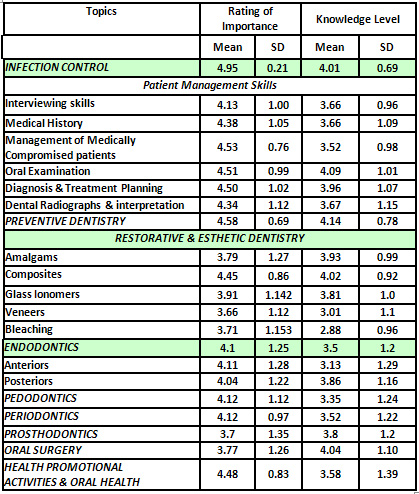
Both
Amalgams
and
glass
ionomer
restorations
were
rated
low
for
importance
as
well
as
knowledge
level
because
composites
is
the
materials
which
is
being
predominantly
used
for
restorations.
Interestingly
both
the
topics
that
is
veneers
and
bleaching
received
low
scores
for
level
of
importance
as
well
as
knowledge
level
probably
because
these
procedures
are
not
being
practiced
in
the
GAHS
dental
facilities
in
the
Primary
Health
Care
Center
dentists
who
comprised
the
major
proportion
of
the
study
population.
Response
to
the
timing
of
the
CME
activity
was
highest
for
a
monthly
event
3.95
(SD
1.38)
while
the
hands
-
on
Training
activity
was
highly
recommended
3.96
(SD
1.29).
For
the
mode
of
self
directed
learning
Journals
were
rated
high
3.64
(SD
1.38).
Quality
CME
can
enhance
the
knowledge
base
and
practice
skills
of
the
participating
health
care
provider
and
is
increasingly
used
as
part
of
the
credentialing
and
reappointment
process.
Continuing
Medical
Education
is
important
not
only
as
a
requirement
for
practice,
but
as
means
for
the
profession
to
achieve
one
of
its
primary
goals:
QUALITY
PATIENT
CARE.
To
our
patients
CME
requirements
are
a
commitment
made
by
the
medical
and
dental
practitioner
to
keep
our
knowledge
and
skills
current.
In
the
implementation
of
any
CME
activities
assessment
strategies
is
critical
to
judge
the
success
of
such
a
program.
For
example
communication
skills
learning
must
be
both
formative
and
summative.
The
knowledge,
skills,
and
attitudes
to
be
assessed
must
be
made
explicit
to
both
learners
and
teachers
alike.
Potential
evaluators
include
local
experts,
course
faculty,
simulated
and
real
patients,
peers,
and
the
learners
themselves.
Formative
assessment
should
occur
throughout
the
communication
skills
curriculum
and
is
intended
to
shape
and
improve
future
behaviors.
This
requires
direct
observation
(in
person
or
videotaped)
of
the
skills
during
role-play
activities,
with
standardized
patients,
and
with
real
patients.
The
feedback
provided
should
be
balanced
and
nonjudgmental.
Self-assessment
during
the
learning
process
should
be
encouraged.
Assessment
of
communication
skills
must
include
direct
observation
of
performance.
Evaluation
of
setting
a
therapeutic
environment,
gathering
data
and
providing
information
and
closure
must
be
included.
Evaluation
of
advanced
skills,
including
use
of
interpreters,
providing
bad
news
and
promoting
behavior
change
should
be
done
as
well.
Criteria
should
match
the
novice
level
of
the
end
of
second
year
student,
who
should
be
able
to
identify
the
critical
issues
for
effective
communication
and
perform
the
skills
under
straightforward
circumstances.
Specific
tools
can
be
chosen
from
among
the
following:
•
Standardized
patients
•
OSCE's
•
Observed
performance
with
patients
and
others
•
Written
reflections
describing
how
a
learner
would
approach
a
certain
situation
•
MCQ's
Adult
Learning
Principles
In
addition
to
being
"champions,"
teachers
need
to
employ
principles
of
adult
learning
in
their
approach
to
teaching
these
topics.
The
knowledge
base
for
any
of
these
topics
is
changing
every
day
with
the
information
and
technology
explosion
that
has
occurred
in
the
last
quarter-century.
Genetics
is
a
perfect
example
of
a
topic
subject
to
rapid,
ongoing
revision
based
upon
new
research
findings.
Physicians
must
learn
how
to
identify
their
own
learning
needs
and
address
these
needs
effectively,
in
order
to
keep
up
with
the
ever-advancing
knowledge
base
in
most
of
these
topic
areas.
Self-Awareness
In
addition
to
fostering
an
enthusiastic
approach
to
lifelong
learning,
the
instructional
method
must
encourage
physicians
to
reflect
upon
their
own
lives
in
relationship
to
the
topic.
The
topic
of
geriatrics,
for
example,
emphasizes
many
issues
that
every
student
will
face,
through
the
aging
of
parents
and
themselves.
Substance
abuse,
end-of-life,
and
other
topics
often
elicit
strong
emotions
within
students,
as
physicians
remember
past
experiences
or
recognize
ongoing
struggles
within
their
own
lives.
Teachers
must
create
environments
that
are
safe
enough
to
foster
trust
and
intimacy,
and
yet
challenge
physicians
to
reflect
upon
their
own
experience
of
life,
as
they
develop
a
basic
level
of
mastery
in
these
special
topic
areas.
"CME
really
is
about
changing
behavior
through
education-about
doing
something
different,
doing
it
better."
The
bottom
line
of
CME
in
the
past
has
been
the
activities
we
produced-how
many,
how
much
they
cost,
how
many
people
came.
In
essence,
CME
was
more
activity-oriented
than
learner-oriented.
"Not
only
do
you
have
to
focus
on
the
learner,"
"you
have
to
focus
on
the
learner
in
the
context
in
which
they
are
learning,
which
is
the
healthcare
environment
where
they
practice
medicine."
The
aim
of
the
proposal
is
to
'to
provide
leadership
in
the
delivery
of
high
quality
education,
for
the
primary
care
team,
in
the
context
of
a
caring
and
vibrant
academic
environment'
QUESTIONNAIRE:
CME
FOR
DENTISTS
AND
DENTAL
ASSISTANT
Please
rate
each
skill
below:
d)
In
order
of
importance
for
you
to
acquire
or
possess.
(1
=
least
important
to
5
=
most
important)
e)
By
rating
your
own
current
level
of
performance.
(1
=
basic
to
5
=
highly
skilled)
f)
Recommend
CME
activity
on
level
of
priority
(1
=
least
to
5
=
highest
priority)
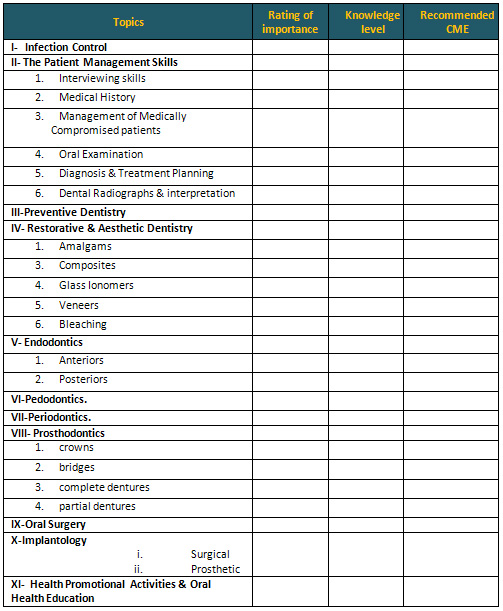
Any
other
skills
or
topic
you
feel
are
important
for
your
academic
development:
FORMAT
OF
CME
In
order
of
preference
rate
the
below
activities
from
1
to
5
1
being
least
appropriate,
5
most
appropriate
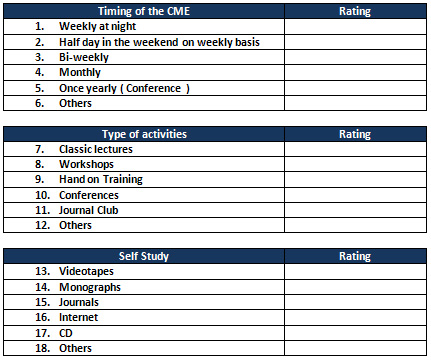
Personal
Information
(optional)
Name
___________________________
Degree
___________________________
E-mail
___________________________
Work
place
_______________________
Are
you
willing
to
help
in
the
teaching
process
of
the
CME
|
|
.................................................................................................................

|
| |
|

